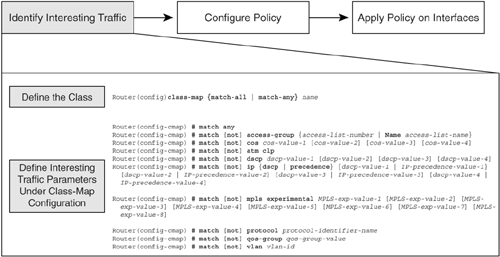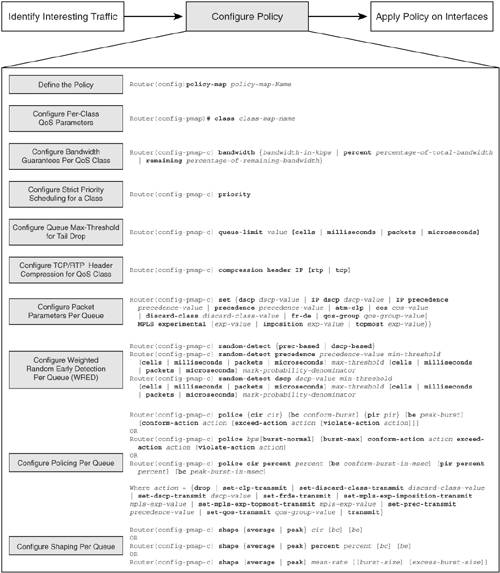Modular QoS CLI: Configuration of QoS on Cisco Routers
Modular QoS CLI Configuration of QoS on Cisco Routers
Modular QoS CLI (MQC) is the Cisco implementation for configuration of QoS on its routers. Prior to the implementation of MQC on Cisco routers, all configurations were performed at the interface level for QoS policies. In the event that the router had a large number of networking interfaces, this configuration was often cumbersome and time-consuming. With MQC, the actual QoS policy has been decoupled from the interface on which it is applied. Therefore, multiple policies can be configured and do not take effect until they are applied to an interface. The modular QoS CLI implements a simple architecture to configure QoS by the definition of the following:
|
Step 1. |
Identify the interesting traffic (classification) that will map to a traffic class using the configuration of class maps – Interesting traffic definition can be defined to match based on many properties of an IP or an MPLS packet. However, refer to the documentation for the particular product as well as the IOS version prior to implementation and configuration of QoS policy using MQC. Figure 13-10. Identify Interesting Traffic 
Note that a large number of options are available under the match keyword for the class-map configuration. The most commonly used ones have been shown in Figure 13-9. Refer to the documentation pertaining to your particular chassis as well as the IOS version for more information on options available at Cisco.com. Note that the not keyword can be used in conjunction with most options available under the interesting traffic definition. |
|
Step 2. |
Define the QoS policy to be applied per class using policy maps – The QoS policy applied per class is defined as the PHB for that specific class. This usually includes the functions of congestion management, congestion avoidance, and traffic shaping and policing on a per class basis. It will also define if the specified class requires preferential treatment as in the case of LLQ. Therefore, this is often where you will find the police, shape, priority, bandwidth, and random-detect commands per class. Figure 13-11. Configure Policy 
With random-detection, the queue can be configured to selectively drop packets to avoid the queue from filling up leading to tail-drop scenarios. Therefore, the minimum threshold at which the selective drop begins and the maximum threshold before the tail drop are to be configured along with the drop probability denominator, which defines the ratio of packets to be dropped at the maximum threshold. Note that the smaller the drop probability denominator, the more aggressive the congestion avoidance scheme. The most common variables are that the bandwidth command needs to be configured prior to random-detect configuration, as well as random-detect cannot be performed on an LLQ as defined by the priority command mentioned earlier. Hence, random-detection can be done based on Precedence values or DSCP values, and drops can be done selectively or more aggressively based on the Precedence or DSCP values. Policing is the process of identifying if traffic conforms to a certain profile. Traffic not conforming to the profile can be either reconfigured (lowered in priority and class) and transmitted or simply dropped. The important difference between traffic shaping and policing is that packets are not dropped that do not match a traffic profile. In shaping, out-of-profile packets are queued and perhaps re-marked and sent at a later time interval. The shaping can be performed using peak or average rates and usually forms a single token bucket model, but, in some higher end routers manufactured by Cisco, the dual token bucket model is used in which a separate bucket is maintained for tokens matching the committed burst rate and the excess burst rates. The key item to note is that shaping is always performed on egress and not on ingress whereas policing can be performed on ingress as well. |
|
Step 3. |
Apply PHB QoS policy per interface using service-policy commands – This final step in the MQC structure involves the application of a QoS policy on an interface (policy map) using the service-policy command. The PHB can be defined either on input or output and can map to different PHBs in either operation. The configuration step is identified in Figure 13-12. Figure 13-12. Applying Policy to an Interface 
In this section, you were provided an overview of the configurations possible with the Cisco MQC architecture. For more information on configuration of classification, marking, congestion management, congestion avoidance, traffic shaping, and policing, visit the Cisco online documentation at http://www.cisco.com/univercd/cc/td/doc/product/software/ios120/12cgcr/qos_c/index.htm. |
MPLS Overview
- MPLS Overview
- Unicast IP Forwarding in Traditional IP Networks
- Overview of MPLS Forwarding
- MPLS Terminology
- MPLS Control and Data Plane Components
- MPLS Operation
- Special Outgoing Label Types
- Penultimate Hop Popping
- Frame-Mode MPLS
- Cell-Mode MPLS
Basic MPLS Configuration
- Basic MPLS Configuration
- Frame-Mode MPLS Configuration and Verification
- Cell-Mode MPLS over ATM Overview, Configuration, and Verification
- Command Reference
Basic MPLS VPN Overview and Configuration
- Basic MPLS VPN Overview and Configuration
- VPN Categories
- MPLS VPN Architecture and Terminology
- MPLS VPN Routing Model
- MPLS VPN Basic Configuration
- Outbound Route Filters
- Command Reference
PE-CE Routing Protocol-Static and RIP
- PE-CE Routing Protocol-Static and RIP
- Static PE-CE Routing Overview, Configuration, and Verification
- Static PE-CE Routing Command Reference
- RIPv2 PE-CE Routing Overview, Configuration, and Verification
- RIPv1 PE-CE Routing Configuration and Verification
- RIP PE-CE Routing Command Reference
PE-CE Routing Protocol-OSPF and EIGRP
- PE-CE Routing Protocol-OSPF and EIGRP
- OSPF PE-CE Routing Protocol Overview, Configuration and Verification
- EIGRP PE-CE Routing Protocol Overview, Configuration, and Verification
Implementing BGP in MPLS VPNs
- Implementing BGP in MPLS VPNs
- BGP PE-CE Routing Protocol Overview, Configuration, and Verification
- Implementing Route-Reflectors in MPLS VPN Networks
- Case Study-Hub and Spoke MPLS VPN Network Using BGP PE-CE Routing for Sites Using Unique AS Numbers
- Case Study-Hub and Spoke MPLS VPN Network with Sites Using Same AS Numbers
- Command Reference
Inter-Provider VPNs
- Inter-Provider VPNs
- Overview of Inter-Provider VPNs
- Option 1: Inter-Provider VPN Using Back-to-Back VRF Method
- Option 2: Inter-Provider VPNs Using ASBR-to-ASBR Approach
- Option 3: Multi-Hop MP-eBGP Between RR and eBGP Between ASBRs
- Option 4: Non-VPN Transit Provider
- Case Study-Inter-AS Implementing Route-Reflector and BGP Confederation in Provider Networks
- Case Study-Multi-Homed Inter-AS Provider Network
- Command Reference
Carrier Supporting Carriers
- Carrier Supporting Carriers
- Carrier Supporting Carriers Overview
- Deployment Scenarios with CSC Architecture
- CSC Architecture Benefits
- Command Reference
MPLS Traffic Engineering
- MPLS Traffic Engineering
- TE Basics
- MPLS TE Theory
- Constraint-Based Routing and Operation in MPLS TE
- Configuring MPLS TE
- Command Reference
Implementing VPNs with Layer 2 Tunneling Protocol Version 3
- Implementing VPNs with Layer 2 Tunneling Protocol Version 3
- L2TPv3 Overview
- Configuring L2TPv3 Tunnels for Layer 2 VPN
- Configuring L2TPv3 Static Tunnels
- Configuring L2TPv3 Dynamic Tunnels
- Implementing Layer 3 VPNs over L2TPv3 Tunnels
- Command Reference
Any Transport over MPLS (AToM)
- Any Transport over MPLS (AToM)
- Introduction to Layer 2 VPNs
- Implementing AToM for Like to Like Circuits
- L2 VPN-Any to Any Interworking
- Local Switching
- Command Reference
Virtual Private LAN Service (VPLS)
- Virtual Private LAN Service (VPLS)
- VPLS Overview
- VPLS Topology-Single PE or Direct Attachment
- Hierarchical VPLS-Distributed PE Architecture
- Command Reference
Implementing Quality of Service in MPLS Networks
- Implementing Quality of Service in MPLS Networks
- Introduction to QoS-Classification and Marking
- MPLS QoS Implementation
- MPLS QoS Operating Modes
- Modular QoS CLI: Configuration of QoS on Cisco Routers
- Configuration and Implementation of MPLS QoS in Uniform Mode and Short Pipe Mode Operation
- Implementing MPLS QoS for Layer 2 VPN Implementations
- Command Reference
MPLS Features and Case Studies
- MPLS Features and Case Studies
- Case Study 1: Implementing Multicast Support for MPLS VPNs
- Case Study 2: Implementing Multi-VRF CE, VRF Selection Using Source IP Address, VRF Selection Using Policy-Based Routing, NAT and HSRP Support in MPLS VPN, and Multicast VPN Support over Multi-VRF CE
- Case Study 3: Implementing Layer 2 VPNs over Inter-AS Topologies Using Layer 2 VPN Pseudo-Wire Switching
- Case Study 4: Implementing Layer 3 VPNs over Layer 2 VPN Topologies and Providing L2 VPN Redundancy
- Case Study 5: Implementing Dynamic Layer 3 VPNs Using mGRE Tunnels
- Case Study 6: Implementing Class-Based Tunnel Selection with MPLS Traffic Engineering
- Case Study 7: Implementing Hub and Spoke Topologies with OSPF
- Case Study 8: Implementing Hub and Spoke Topologies with EIGRP
- Case Study 9: Implementing VPLS Services with the GSR 12000 Series
- Case Study 10: BGP Site of Origin
- Command Reference
EAN: 2147483647
Pages: 130
